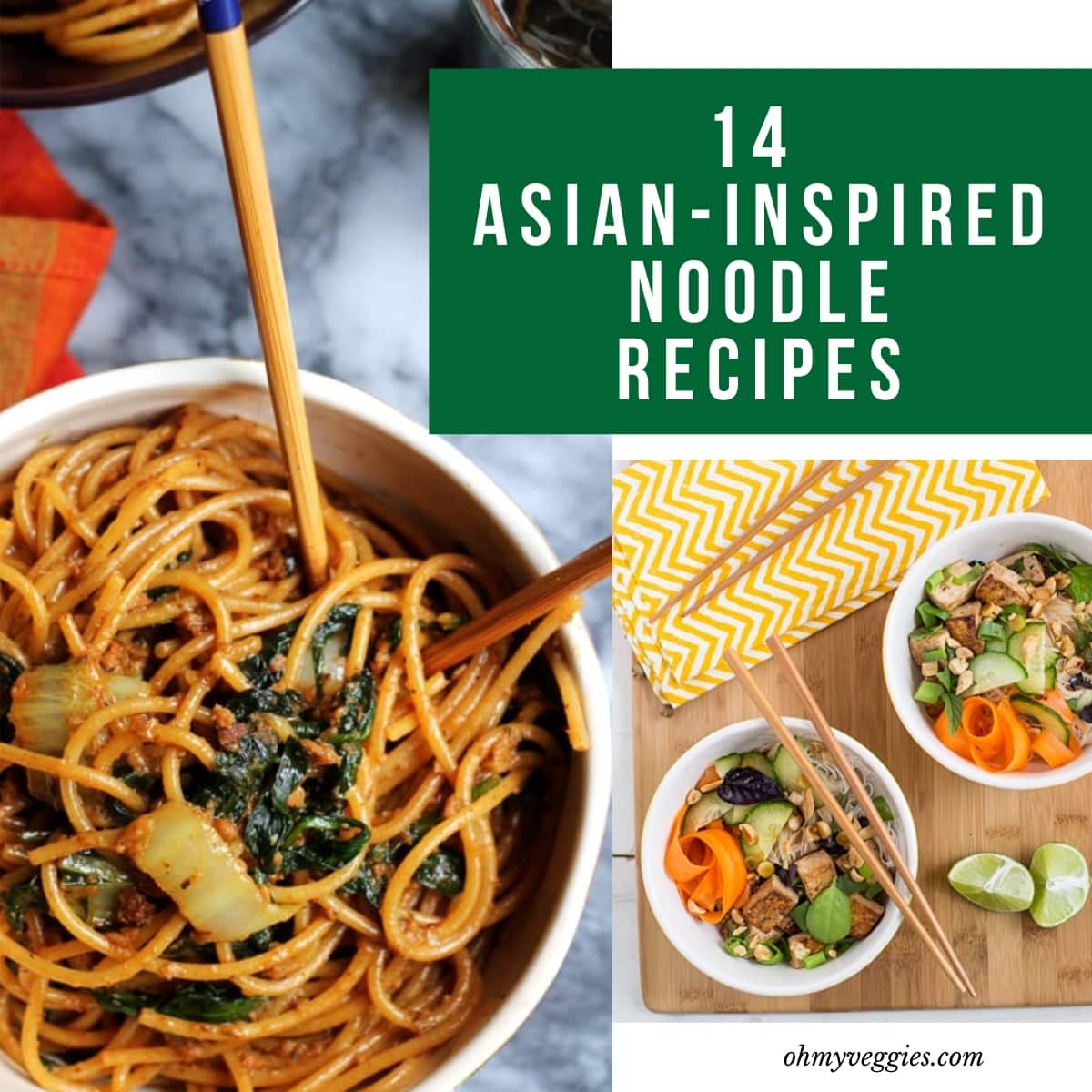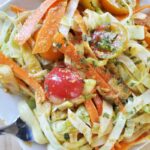Discover the vibrant world of raw vegan Asian-inspired noodles! This culinary adventure guides you through crafting delicious and healthy noodle dishes bursting with fresh flavors and textures. We’ll explore a variety of vegetables, innovative sauce creations inspired by diverse Asian cuisines, and elegant plating techniques to elevate your presentation. Prepare to tantalize your taste buds and impress your guests with these stunning, plant-based noodle masterpieces.
From the careful selection of vegetables like vibrant carrots, crisp cucumbers, and peppery daikon radish, to mastering the art of julienning and spiralizing, we’ll cover every step. Learn to create authentic Asian-inspired flavors without compromising your vegan lifestyle, exploring umami-rich sauces and innovative garnishes. This comprehensive guide provides multiple noodle options, sauce recipes, and plating styles, empowering you to customize your creations and unleash your culinary creativity.
Ingredient Selection & Preparation

Creating a vibrant and flavorful raw vegan Asian-inspired noodle dish hinges on selecting the right vegetables and preparing them to showcase their natural textures and tastes. The key is to choose ingredients that offer a diverse range of colors, flavors, and textures, complementing each other beautifully. Proper preparation techniques ensure optimal crispness and prevent unwanted mushiness.
The ideal vegetables for this dish should be crisp, colorful, and offer a range of textures and flavors that are characteristic of Asian cuisine. Consider their nutritional benefits as well, selecting options rich in vitamins, minerals, and antioxidants.
Vegetable Selection and Nutritional Benefits
Five excellent choices include carrots, bell peppers, cucumbers, daikon radish, and shiitake mushrooms (though technically a fungus, it’s used like a vegetable here).
Carrots offer a sweet crunch and are rich in beta-carotene, a powerful antioxidant converted to Vitamin A in the body, crucial for eye health and immune function. Their vibrant orange color adds visual appeal. Bell peppers, particularly red and yellow varieties, provide sweetness and a satisfying crunch, boasting high levels of Vitamin C, a potent antioxidant vital for immune support and collagen production. The vivid colors contribute to the dish’s aesthetic appeal. Cucumbers offer a refreshing coolness and hydrating crunch, contributing to the dish’s overall lightness. They are a good source of Vitamin K, important for blood clotting and bone health. Daikon radish provides a subtly spicy and peppery bite, offering a textural contrast and a unique flavor dimension. It’s a good source of Vitamin C and antioxidants. Shiitake mushrooms, while not a vegetable, offer a rich umami flavor and meaty texture, adding depth to the dish. They are a good source of B vitamins and minerals.
Vegetable Preparation Techniques
Preparing these vegetables for a raw dish requires techniques that maintain their crispness and enhance their flavor. Juliennning, spiralizing, and finely slicing are excellent methods.
Carrots and daikon radish benefit from julienning, creating thin, matchstick-like strands that are visually appealing and offer a pleasant texture. Bell peppers can be julienned or thinly sliced, depending on the desired texture. Cucumbers are best thinly sliced or made into ribbons using a vegetable peeler for a refreshing, delicate element. Shiitake mushrooms can be thinly sliced or even finely minced, depending on the desired texture and how you want them to integrate into the dish. The goal is to create uniformly sized pieces for even cooking (in this case, “cooking” refers to the marinating process) and a visually appealing presentation. Avoid over-processing to maintain the vegetables’ freshness and crispness.
Raw Vegan Noodle Comparison
| Noodle Type | Texture | Flavor Profile | Nutritional Value |
|---|---|---|---|
| Zucchini Noodles | Delicate, slightly tender; can become watery if not handled carefully. | Mildly sweet, slightly grassy. | Good source of Vitamin C, potassium, and fiber. |
| Sweet Potato Noodles | Firm, slightly chewy; holds its shape well. | Sweet, earthy. | Rich in Vitamin A, fiber, and potassium. |
| Kelp Noodles | Jelly-like, translucent; almost neutral texture. | Subtly salty, almost flavorless, making it a great base. | Excellent source of iodine, minerals, and fiber. Low in calories. |
Recipe & Step-by-Step Instructions
This recipe creates a vibrant and refreshing raw vegan noodle dish inspired by Asian flavors. The combination of textures and tastes offers a delightful culinary experience, showcasing the versatility of raw vegan cuisine. The steps are designed to be easily followed, even for novice cooks.
Ingredients
This section details the precise measurements and types of ingredients needed for the recipe. Accurate measurements are crucial for achieving the desired texture and flavor balance.
- Noodles: 8 ounces zucchini noodles (or other preferred raw vegetable noodles like carrot or sweet potato), julienned thinly using a spiralizer or vegetable peeler.
- Sauce: 1/4 cup tamari (or coconut aminos), 2 tablespoons rice vinegar, 1 tablespoon sesame oil, 1 tablespoon maple syrup, 1 teaspoon grated ginger, 1 clove garlic, minced.
- Vegetables: 1/2 cup shredded carrots, 1/2 cup shredded red cabbage, 1/4 cup chopped red bell pepper, 1/4 cup chopped scallions.
- Garnish: 2 tablespoons toasted sesame seeds, 1 tablespoon chopped fresh cilantro, 1 tablespoon chopped peanuts (optional).
Step-by-Step Preparation
This section provides a detailed, step-by-step guide to preparing the dish, ensuring a successful outcome. Following these instructions carefully will help maintain the freshness and integrity of the raw ingredients.
- Prepare the Sauce: In a small bowl, whisk together the tamari, rice vinegar, sesame oil, maple syrup, grated ginger, and minced garlic until well combined. The sauce should be smooth and slightly thick.
- Prepare the Vegetables: Shred the carrots and red cabbage using a food processor or by hand. Finely chop the red bell pepper and scallions. The vegetables should be uniformly sized for even cooking and visual appeal.
- Combine Ingredients: In a large bowl, gently toss the zucchini noodles with the prepared sauce. Add the shredded carrots, red cabbage, red bell pepper, and scallions. Carefully mix to ensure all the noodles are coated with the sauce. Avoid overmixing to prevent the noodles from becoming mushy.
- Garnish and Serve: Transfer the noodle mixture to a serving bowl. Sprinkle generously with toasted sesame seeds, chopped cilantro, and chopped peanuts (if using). The garnish adds a final touch of flavor and visual appeal. Serve immediately for optimal freshness and texture.
Tips and Tricks for Success
This section offers advice on maintaining optimal texture and flavor, addressing potential challenges during preparation. Following these tips will enhance the overall culinary experience.
- Choosing Noodles: Zucchini noodles are a popular choice for their mild flavor and delicate texture. However, you can experiment with other raw vegetable noodles like carrot or sweet potato for variations in taste and color.
- Sauce Consistency: Adjust the amount of maple syrup to control the sweetness of the sauce. For a tangier sauce, add more rice vinegar. Taste and adjust as needed to suit your preferences.
- Preventing Soggy Noodles: Avoid over-mixing the noodles with the sauce, as this can lead to a soggy texture. Gently toss the ingredients to ensure even coating.
- Freshness is Key: Use fresh, high-quality ingredients for the best flavor and texture. Prepare the dish just before serving to maintain its optimal freshness.
Creating delicious and visually stunning raw vegan Asian-inspired noodles is now within your reach. By following these detailed steps and experimenting with different vegetables, sauces, and plating techniques, you can craft unique and flavorful dishes that are as healthy as they are beautiful. Embrace the artistry of raw vegan cuisine and delight in the satisfying experience of creating and sharing these extraordinary noodle creations. Remember, the key is to have fun and let your creativity shine through!
FAQ
Can I make these noodles ahead of time?
It’s best to prepare the noodles and sauces just before serving to maintain optimal freshness and texture. However, you can prep the vegetables in advance and store them separately in airtight containers in the refrigerator.
What if my noodles are too soggy?
Soggy noodles usually result from improper preparation or storage. Ensure you use appropriate techniques (like patting them dry after preparation) and avoid over-dressing them with sauce. Store prepared noodles separately from the sauce until serving.
Are there any substitutions for specific ingredients?
Many ingredients can be substituted based on availability and preference. For example, different types of noodles can be used, and alternative vegetables can be chosen based on your liking. Be mindful of the potential impact on flavor and texture.
What are some tips for achieving a perfect balance of flavors?
Achieving a balanced flavor profile involves careful consideration of sweet, sour, salty, and umami elements. Taste your sauce as you go, and adjust the ingredients accordingly. Don’t be afraid to experiment!


